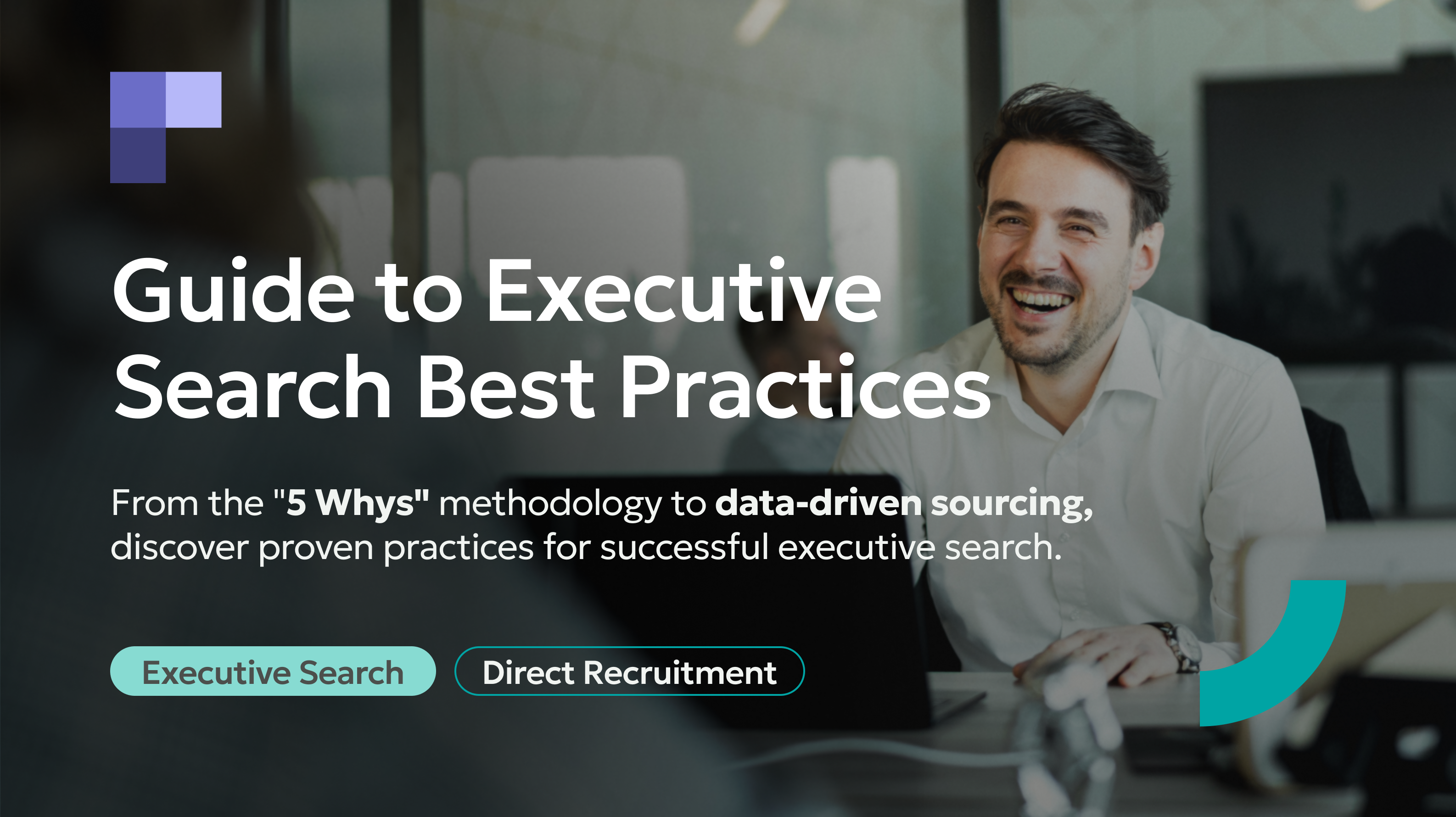Key Takeaways
- Understanding the nuances of executive search is critical to success
- Best practices like structured interviews, data-driven sourcing, and prioritizing cultural fit ensure top-tier hires.
- Partnering with a trusted executive search firm like GetFrankly can provide a competitive edge.
Hiring the wrong executive might break an entire organization. You’ve probably already read the famous quote: People don’t leave organizations; they leave bad managers. From our experience at GetFrankly, this checks out. We focus on creating a top-class experience in hiring executive roles.
We’ve gathered our knowledge, and in this article, we want to provide you with actionable insights that you can use to refine your executive search process.
Understanding the Recruitment Spectrum
Before delving into actionable insights, it’s essential to understand the executive talent acquisition spectrum:
- Recruitment & Selection
This is the broadest category, encompassing the standard hiring process. It involves sourcing, screening, interviewing, and selecting candidates.
- Talent Acquisition
A more strategic approach, talent acquisition focuses on long-term workforce planning and employer branding, ensuring a steady pipeline of skilled professionals.
- Direct Search (Headhunting)
This method is used for specialized roles where active candidates are scarce. It involves targeted outreach to passive candidates who may not be actively job-seeking but fit the role’s requirements.
- Executive Search
At the highest level of complexity, an executive search is conducted for top leadership roles, requiring deep industry expertise and a highly personalized approach. Typically managed by specialized firms, it combines sourcing, recruitment, and selection at the most strategic level.
Each approach involves sourcing, recruitment, and selection, but the strategy and complexity of these stages vary significantly.
Top 10 Best Practices in Executive Search
1. Conduct a Thorough Needs Analysis with Key Stakeholders
Alignment among key stakeholders is crucial in executive search. A clear understanding of the role ensures you address the underlying business problem
One of the techniques that we use at GetFrankly is the “5 Whys.”
For example, if a company is hiring a Chief Financial Officer (CFO), the recruiter might ask:
- Why do we need a new CFO?
Potential answer: “To optimize financial strategy.”
- Why is financial strategy optimization critical now?
Potential answer: “Because we’re preparing for an IPO.”
- Why is the IPO driving this need?
Potential answer: “Our current CFO lacks experience with IPOs.”
- Why haven’t we addressed this earlier?
Potential answer: “Our growth trajectory shifted recently.”
- Why is this the best time for the hire?
Potential answer: “We’re aligning leadership with our strategic vision.”
Calibrate the Candidate’s Profile
Once the role is defined, we use tools like SHL competency-based scorecards. If you haven’t heard about them, these scorecards are structured tools that assess candidates across predefined competencies essential for leadership success. For example:
- Leadership agility: The ability to adapt strategies in response to changing market conditions.
- Decision-making excellence: Evaluating how well candidates handle high-stakes decisions with incomplete information.
- Strategic vision: Measuring the candidate’s ability to align long-term goals with organizational objectives.
Each candidate is rated against these competencies using a consistent scoring system, reducing subjectivity and providing clear, actionable insights.
Alternatively, the KSAO model (Knowledge, Skills, Abilities, Other Characteristics) offers a structured framework. Focus on:
- Knowledge: Industry expertise.
- Skills: Technical proficiencies.
- Abilities: Strategic thinking or adaptability.
- Other characteristics: Cultural fit and leadership style.
You can also consider focusing on three dimensions:
- Can Do: Does the candidate possess the necessary skills?
- Will Do: Are they motivated to excel in the role?
- Will Fit: Do they align with the company’s culture?
Benchmark and Identify Competition
Once you have clarity and the methods in place, you should also look into what competitors are doing and what the benchmark in the industry is.
2. Leveraging Advanced Tools and Technology
Another best practice is to use the tools and technology we all have to make the executive recruitment process smoother. Some tools that we recommend using are:
- Applicant Tracking Systems (ATS): Manage candidate pipelines efficiently.
- LinkedIn Recruiter: Conduct targeted outreach to passive talent.
- Assessment Tools: Psychometric tests and case studies provide deeper insights into candidates’ capabilities and fit.
3. Embracing Data-Driven Sourcing
Since we have the technology, we also have the data to help us with decision-making.
Key Metrics to Monitor
However, it’s essential to understand what you’re measuring to effectively utilize the data. Our approach here stands apart from what we’ve observed at other executive search agencies.
You will usually find information about metrics like time-to-fill, time-to-hire, and time spent in each stage, which are highly relevant. Still, these metrics are more appropriate in high-volume hiring scenarios.
However, in executive search, the focus shifts to more qualitative metrics. You should measure things like:
- Quality of hire
- Communication effectiveness throughout the process (both with the company and the candidates)
- NPS score
4. Proactive Talent Pipelining
Networking and Engagement Strategies
As we mentioned at the beginning of the article, creating a pipeline of candidates is one of our best strategies.
At GetFrankly, we use the “6 by 6” approach. This means that a recruiter focuses on engaging six potential candidates every six months in a specific domain or role.
For example, a recruiter building an IT executive pipeline can contact high-potential leaders for exploratory conversations, even without immediate openings, to maintain active relationships.
Another approach that we use is conducting “getting-to-know-you” interviews. These interviews have no immediate stakes but help create a portfolio of valuable candidates.
From our experience, when it comes to executive levels, these professionals often rely on recruiters to represent them and open doors to opportunities. They might even send links to roles they’re interested in, trusting the recruiter to negotiate on their behalf. That’s why, if you have a business and are looking to hire an executive, you should partner with executive-search recruitment agencies to have access to these types of candidates.
5. Conducting Structured Interviews
Another thing you can do is to use structured interviews that ensure objectivity.
You can use standardized guides to assess key competencies like:
- Strategic vision
- Team leadership
- Adaptability
‘’At GetFrankly, we use competency-based interviews. What is different from the traditional interview is that competency-based questions target specific skills are past behaviors. Their goal is to predict future performance based on past behavior.’’
Elena Cramba – Partner, Fractional and Executive Search
6. Assessing Cultural Fit
One of the most essential steps in the process is to assess the cultural fit. You can use one of the abovementioned tools or create leadership simulation exercises. For example, ask candidates to lead a virtual team discussion or present a strategic plan to assess how their leadership style fits within your culture.
7. Prioritizing Diversity and Inclusion in Leadership
We all know that a diverse team equals a creative team. When you source candidates, pay attention to avoid biased hiring.
While sourcing candidates from varied backgrounds is important, the focus should remain on aligning with the client’s specific needs and cultural climate.
“At GetFrankly, we prioritize competencies and fit rather than imposing diversity. However, larger companies with internal DEI policies often request candidates who meet specific diversity criteria. In such cases, like projects we’ve managed for companies in Denmark and other Nordic countries, we align our search process to fulfill these requirements without compromising quality or fit.’’
Darius Popirtac, Managing Partner
8. Adapting to Remote and Hybrid Roles
Another skill you should analyze is the candidates’ ability to effectively lead distributed teams and utilize virtual collaboration tools.
Example 1: Virtual Leadership Assessment
Design a scenario-based interview where candidates lead a simulated remote team meeting. Evaluate their communication clarity, ability to engage team members, and proficiency with virtual collaboration tools like Zoom or Microsoft Teams.
Example 2: Track Record of Remote Success
Ask candidates to provide examples of past successes in managing remote or hybrid teams. For instance, they might describe how they maintained team cohesion, achieved productivity goals, or overcame challenges unique to remote work environments.
9. Employer Branding and Candidate Experience
If employer branding isn’t yet part of your strategy, you should add it because it plays a massive role in attracting top executive talent.
Clearly articulate your company’s mission, values, and culture in all candidate communications. Highlight success stories and testimonials to build trust and credibility. Additionally, ensure a seamless candidate experience by maintaining transparency and timely feedback.
10. Collaborating with Executive Search Partners
From what you already saw, hiring for an executive role requires expertise, recruitment tools, and a strategic approach.
If you decide to hire someone to take care of the recruitment process for you, here’s what we recommend you look into:
- Industry expertise: Ensure the firm deeply understands your industry’s unique challenges and requirements.
- Track record: Look for a proven history of successfully placing candidates in similar roles or industries.
- Cultural alignment: Assess whether the firm aligns with your company’s values and understands your organizational culture.
- Communication and transparency: A good partner maintains open, honest communication and provides regular updates throughout the process.
Strengthening Your Leadership Team with GetFrankly
We have already applied all these 10 strategies in our work. Our consultants offer tailored strategies to ensure every candidate has a seamless experience.
For example, some of our activity is rooted in the manufacturing industry, where we’ve had the opportunity to assist companies during pivotal moments. One such client, a production company in Salaj, engaged us to support their business scaling efforts. Starting from scratch, we recruited a new management line, including roles such as Commercial Manager, CFO, HR Manager, and Marketing Manager.
This process delivered exceptional results for the client and helped us increase our network. Nicoleta, the CFO we placed, recommended us to an auditing firm, leading to a new client relationship. Additionally, a candidate considered for the Commercial Manager role became a client themselves, engaging us to fill an Area Sales Manager position for their company. These outcomes highlight the exceptional experience we aim to provide to companies and candidates.
Conclusion
Executive search can be a tricky process. However, by implementing some of the best practices from this article, you increase your chances of finding leaders who fit your organization.
Ready to find the perfect leader for your organization? Partner with GetFrankly and let us guide you through a seamless executive search journey. Visit our website to explore our services and access additional resources.
FAQs: Executive Search Best Practices
How long does the executive search process typically take?
It varies, but a thorough process usually takes 8–12 weeks.
What tools can improve the search process?
Tools like ATS, LinkedIn Recruiter, and assessment platforms streamline sourcing and evaluation.
Why should I work with an executive search firm?
Firms bring expertise, networks, and resources that enhance the quality of your search and reduce the risk of a bad hire.
How can I assess cultural fit during the hiring process?
Use leadership simulation exercises or scenario-based questions to evaluate how candidates align with your organization’s values and leadership style.
What are the benefits of proactive talent pipelining?
Building a talent pipeline ensures access to qualified candidates when opportunities arise, reducing time-to-hire and improving hiring outcomes.







